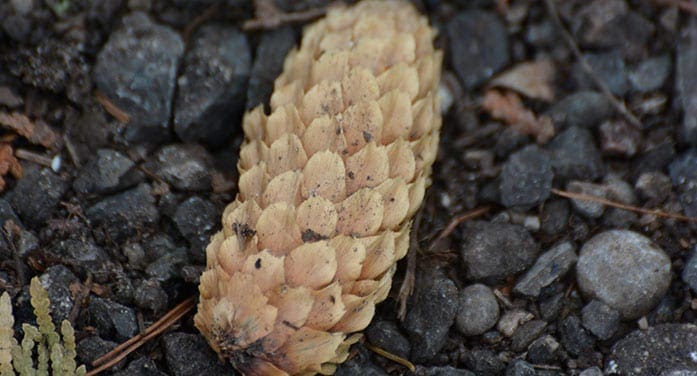 As we welcome spring, we see the remnants of pine and spruce cones previously covered by snow. Few of us think about how important these cones are to the floral and faunal communities – as food and to ensure the next generation of trees is born.
As we welcome spring, we see the remnants of pine and spruce cones previously covered by snow. Few of us think about how important these cones are to the floral and faunal communities – as food and to ensure the next generation of trees is born.
Many species of coniferous trees produce cones – pines, firs, hemlocks, spruce, cedars and larches, to name a few. Alders, which are not coniferous trees, still produce fruiting bodies that mimic the cones of coniferous trees in appearance and function. And like many conifers, these are carried on the tree throughout the winter.
Each species of tree carries two types of cones – one male and one female. Each is different structurally. Female cones usually develop singly and form terminally or laterally on the tree’s new growth, while male cones develop in clusters at the base of the new spring growth and are generally inconspicuous. Both male and female cones take two to three years to form. Female cones tend to persist throughout the season and sometimes beyond, while male cones usually disintegrate soon after releasing their pollen.

A cone is a woody stem where the male and female reproductive organs of the tree are located. These organs are arranged spirally around this stem to form the cone-shaped cluster
The female cone is essentially an armoured seed protector, but many forms of wildlife have learned how to harvest the shielded seeds for food. Red squirrels are masters at collecting unripe cones. Often one can see and hear them snipping the cones off the trees with their sharp teeth and then racing down the tree to collect them for storage in a winter hiding place called a midden. Often these piles can be found in odd places and can contain hundreds of cones. Left alone, many trees sprout from unattended cone stashes, and this is an important seed dispersal method for trees.
Many birds explore the nooks and crannies of the cones as they try to pry the seeds loose or find minute insects hiding among the scales.
One group of birds, the crossbills, have evolved such that they have curved bills that overlap and are designed to twist the seeds out of the protective scales on the cones. Since crossbills are totally reliant on cones for survival, and as many trees don’t produce cones every year, these finches have a nomadic life, wandering the continent searching for good cone crops. Once they find them, they stay and feed, sometimes for months, nesting wherever they find food.

Each species of tree carries two types of cones – one male and one female. Each is different structurally
This nesting behaviour is unique as most birds have a home range where they will nest and then look for food for themselves and their young. Crossbills (and many other finches that feed on cones) simply keep moving until they find food and then stop to nest.
How these birds find these important stands of cone-bearing trees and how they communicate this information to others of their species in the vastness of Canada is a mystery that likely will never be solved.
Oh yeah – when dry, cones make great fire starters for your campfire. But be cautious indoors as they often have a lot of sap in them that can gum up your chimney.
So as you enjoy this spring season, take a look at the trees around you, and maybe you’ll see a crossbill prying seeds off a cone.
Geoff Carpentier is a published author, expedition guide and environmental consultant. Visit Geoff online at www.avocetnatureservices.com, on LinkedIn and Facebook.
The views, opinions and positions expressed by columnists and contributors are the authors’ alone. They do not inherently or expressly reflect the views, opinions and/or positions of our publication. © Troy Media
Troy Media is an editorial content provider to media outlets and its own hosted community news outlets across Canada.

